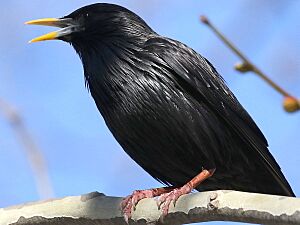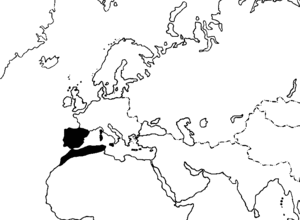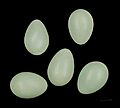Spotless starling facts for kids
Quick facts for kids Spotless starling |
|
|---|---|
 |
|
| in winter plumage | |
 |
|
| breeding male | |
| Conservation status | |
| Scientific classification | |
 |
The spotless starling (Sturnus unicolor) is a cool bird from the starling family. It's a type of passerine bird, which means it's a perching bird. This bird is very similar to the common starling, but it lives in a smaller area. You can find it in places like the Iberian Peninsula (Spain and Portugal), Northwest Africa, southern France, and on islands such as Sicily, Corsica, and Sardinia. Unlike some birds, the spotless starling usually stays in one place and doesn't migrate far.
Contents
What Kind of Bird Is It?
The spotless starling is a close relative of the common starling. These two are the only birds left in their specific group, called Sturnus. Sometimes, where their homes overlap in southwestern France and northeastern Spain, these two types of starlings can have babies together. These mixed babies are called hybrids.
What Does It Look Like?
The adult spotless starling looks a lot like the common starling, but it's a bit bigger. It's about 21 to 23 centimeters long and weighs between 70 and 100 grams. Its feathers are a dark, shiny black, almost like oil. In bright light, they can look a little purple or green.
In spring and summer, its feathers are completely spotless. In winter, you might see very tiny pale spots on its feathers. These spots come from the light tips of its feathers.
One special thing about the spotless starling is its throat feathers. They are twice as long as those on a common starling. They form a shaggy "beard" that looks really cool, especially when the bird is singing! Its legs are bright pink. In summer, the beak is yellow. Males have a bluish base to their beak, while females have a pinkish base. In winter, the beak looks duller, often blackish.
Young spotless starlings are dull brown. They are darker than young common starlings and have a black beak and brown legs. It can be tricky to tell them apart from common starlings, especially in winter when many common starlings are around. You might also confuse it with the common blackbird. But the blackbird has a longer tail and its feathers don't have that shiny look.
Like the common starling, this bird walks instead of hopping. It flies in a strong, straight line. When it flies, its wings look like triangles, and its tail looks short. The spotless starling is a noisy bird and very good at copying sounds. Its calls are similar to the common starling's, but they are louder.
Where Does It Live and What Does It Eat?
The spotless starling can live in many different places. You can find it in open areas like farms, olive groves, and even in towns and cities. It loves places with holm oak trees and is very common in cities like Gibraltar.
In recent years, the number of spotless starlings has grown. They have also spread to new areas. Between 1950 and 1980, they moved into all of Spain. Since 1983, they have started living along the southern coast of mainland France.
Just like its cousin, the common starling, this bird eats many different things. It's an omnivore. It eats all sorts of insects and other small creatures, berries, and even food scraps left by humans. Spotless starlings like to be with other birds. They form large groups, sometimes with common starlings. In winter, these groups can have as many as 100,000 birds!
Family Life
Like most starlings, the spotless starling builds its nest in holes. They can use holes in trees, buildings, or even cracks in cliffs. A female spotless starling usually lays three to five eggs.
Gallery




